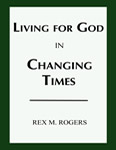Have you ever wondered why an attractive person you see with multiple tattoos and piercings thought they needed these permanent body decorations?
Hi, I’m Rex Rogers and this is episode #214 of Discerning What Is Best, a podcast applying unchanging biblical principles in a rapidly changing world, and a Christian worldview to current issues and everyday life.
Tattoo-less individuals are an endangered species fast nearing extinction, at least it seems so to me. Piercings are not quite as prevalent but are growing in popularity and visibility among Millennials, Gen Z, and the coming Gen Alpha.
I walked out of a grocery store in Maryland to be met by a young woman, I’m guessing about 25, who was wearing very little but tattoos. She had so many tattoos on one arm and shoulder the colors ran together in an amorphous blue. She wore fewer but still a lot of tattoos on her other arm, a large tattoo running up her neck, and tattoos on her fingers. Tattoos of differing sizes and design were scattered up to the bottom of her skirt on both of her legs. She even had a small tattoo on her face. I’ve seen men wear this many tattoos but never a woman. With all that, these tattoos painted what would be considered a very attractive woman I’m guessing by anyone’s judgment. Forgive me for not understanding what motivated this beautiful young woman to do this to herself for life.
Tattooing and piercings as a form of body modification date back about as far as reliable history goes. “The earliest evidence of a tattoo dates back to roughly 3100 BCE.” Decorating the body is as old, it seems, as human vanity. But now it’s made a comeback in American culture where “tats” and ever-more-creative (or shocking) metal adornments in the skin are evident in whatever direction you look. Seemingly everyone, at least under 45 years of age, is tattooed or pierced. Just check out the young people serving you at McDonalds.
“Tattoos have become a more common sight in workplaces around the United States, even making appearances among members of the U.S. House and Senate. Amid this shift, how many Americans have tattoos, why, and do they regret it? A large majority of U.S. adults say society has become more accepting of people with tattoos in recent decades, according to a new Pew Research Center survey. And 32% of adults have a tattoo themselves, including 22% who have more than one.
- 38% of women have at least one tattoo, compared with 27% of men.
- 39% of Black Americans have a tattoo, compared with 35% of Hispanic, 32% of White and 14% of Asian Americans.
- 37% of those with some college or less education have a tattoo, compared with 24% of those with a bachelor’s degree and 21% of those with a postgraduate degree.
- 41% of religiously unaffiliated adults have at least one tattoo, compared with 29% of those who are affiliated with a religion.
- There are no major differences by political party.
- The most commonly cited reason is to honor or remember someone or something: 69% of tattooed adults say this is either a major or minor reason they got any of their tattoos.
- Just under half (47%) say they got a tattoo to make a statement about what they believe, and 32% say they got at least one to improve their personal appearance.”
As to piercings, “in the U.S., approximately 83% of the population has their earlobes pierced and 14% has a piercing outside the earlobe.”
“Members of biker or prison gangs, political fringe groups, or even straight-edge punk rockers and vegans might get certain tattoos as proud displays of their membership (official or unofficial) in these groups. People often get tattoos to defy cultural norms, family expectations, or push the envelope in professional settings.
Sometimes, tattoos are used partly for cosmetic reasons. They can cover over or even incorporate certain imperfections in the skin (such as scars, stretch marks, varicose veins and cellulite) to make them less prominent and visible; and the fact that tattoos won’t be going out of style in the foreseeable future means that this permanent form of cover-up is an attractive proposition. Those who can’t even fathom getting a tattoo due to their fear of needles or because they blanch at the thought of how much pain would be involved (but interestingly) some people get tattoos precisely because they want those sensations.”
Same might be said for piercings. “Different types of body piercings have various symbolism for diverse groups of people. While a surface piercing may be nothing more than a sign of good looks to you, to others, it may have deeper cultural, spiritual, or social meanings…The primary meaning of (ear) lobe piercing (often encouraged among women and now some men) has been lost to time and culture integration. Nowadays, people mostly see lobe piercing as body aesthetics.”
Piercings have exploded in number but still have not achieved the popularity of tattoos. “Since the phenomenon of the mono earring; nose rings, eyebrow piercings, belly rings, and other piercings have become more accepted or tolerated, particularly within Gen Z, as they’re the most likely age group to have septum piercings.”
While not everyone who wears piercings or even nose rings are identifying with the LGBTQ persuasion, it is in some circles considered a signal. “Where identity is often policed or questioned, the septum piercing provides an unspoken understanding to communities falling under the LGBTQ2S+ and alternative umbrellas. This typical facial piercing offers a commonality and a sense of belonging to many who carry a horseshoe or circular ring under their noses.”
“Although newer generations have somewhat embraced overall body modifications, workplace dress code may not be as progressive with facial piercings nor tattoos. Employers are still allowed to ask their workers to hide or remove any piercings or tattoos at their own discretion.”
“The adoption of advanced materials like titanium and surgical steel is also on the rise. These materials reduce allergy risks and improve the safety of body piercings…The global body piercing jewelry market is projected to grow from USD 8.15 billion in 2024 to USD 10.89 billion by 2031, reflecting a compound annual growth rate (CAGR) of 6.14%.”
From the beautiful to the bizarre tattoos and piercings tend to provoke emotional response.
When Christians ask questions about tattoos or piercings, someone cites the Old Testament book of Leviticus: “Do not cut your bodies for the dead or put tattoo marks on yourselves. I am the LORD” (19:28).
Some people quote this verse as a statement outlawing tattoos or piercings, period. But this isn’t a valid interpretation. This verse commanded the Israelites to avoid certain funeral practices wherein bodies were marked in some pagan hope of attaining a good afterlife. This verse doesn’t really address present-day tattooing or piercing. So, we look to the New Testament, only to discover it says nothing about whether a person should or may acquire a tattoo or piercing.
While I am not a fan of most tattoos and certainly many piercings, I’ve always considered this kind of body modification a Christian liberty issue. In other words, God did not say “Thou shalt,” nor did he say “Thou shalt not” with respect to tattoos or piercings.
- “Body piercing is not explicitly mentioned in the Bible, leaving the morality of it open to interpretation.
- Scripture offers guidance on inner beauty, modesty, and the importance of blessings that surpass outward adornment.”
He left these matters in the so-called “gray area,” so we must reckon what to do and “be fully convinced in (our) own minds” (Romans 14:5).
While God didn’t give us rules, he did give us principles to help us answer this “matter of conscience,” one of which is that not everything we can do we should do. In 1 Cor. 10:23 the Apostle Paul noted the core of the Christian liberty doctrine: “I have the right to do anything,” you say—but not everything is beneficial. I have the right to do anything”—but not everything is constructive.”
Whether we acquire tattoos or body piercings should lead us to careful spiritual discernment about what is best, what will honor God, what will allow us to serve him fully?
Certainly, I feel for people, like the young woman entering the Maryland grocery store, whose bodies are plastered with tattoos. It's their free choice, but I believe they've made an unwise, irrevocable one.
For those who may not like body art, it’s worth mentioning that tattooing and piercing are fads. When I was young, I wore bell bottom pants and longer hair.
I still like long hair but, well, no more flared leg pants. Tattoos and piercings will have their day and then will, someday, literally fade away. Fickle fashion fads are here today, gone tomorrow.
Well, we’ll see you again soon. This podcast is about Discerning What Is Best. If you find this thought-provoking and helpful, follow us on your favorite podcast platform. For more Christian commentary, see my website, r-e-x-m as in Martin, that’s rexmrogers.com, or check my YouTube channel @DrRexRogers.
And remember, it is for freedom that Christ has set us free. Stand firm.
© Rex M. Rogers – All Rights Reserved, 2025
*This podcast blog may be reproduced in whole or in part with a full attribution statement. Contact me or read more commentary on current issues and events at www.rexmrogers.com/ or my YouTube channel @DrRexRogers, or connect with me at www.linkedin.com/in/rexmrogers or https://x.com/RexMRogers.


